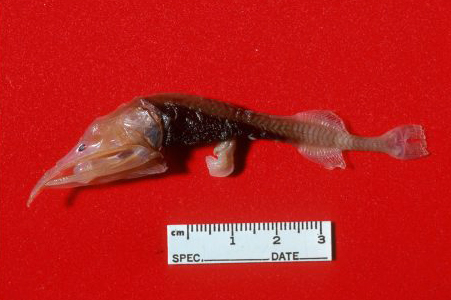Birdsnout Whalefish, Rhamphocetichthys savagei Paxton 1989
Other Names: Bird-snouted Whalefish, Savage's Birdsnouted Whalefish

Paratype of the Birdsnout Whalefish, Rhamphocetichthys savagei (AMS I.26872-001), from the Gulf of California, Mexico, November 1967. Source: Greg Millen / Australian Museum. License: CC By Attribution-NonCommercial
Summary:
A slender dark brown whalefish with a very long snout. males and juveniles of this species are unknown.
Cite this page as:
Bray, D.J. 2024, Rhamphocetichthys savagei in Fishes of Australia, accessed 27 Jun 2025, https://fishesofaustralia.net.au/Home/species/1694
Birdsnout Whalefish, Rhamphocetichthys savagei Paxton 1989
More Info
|
Distribution |
Coral Sea, off Cape York Peninsula, Queensland. Elsewhere the species is widespread in waters within 25° of the Equator in the western North Atlantic, and the eastern and western tropical Pacific. |
|
Features |
Females:Dorsal fin 15-17; Anal fin 15-17; Pectoral fin 21-24; Caudal fin 16 principle rays; Lateral line pores 31-40; Gill arches 3; Vertebrae: 43-45 (total). Body very elongate, head long, narrow, 20-30% SL; snout very long, pointed (twice in HL); mouth huge (third of body length), upper jaw overhanging lower jaw; eye tiny; nasal organ small. Upper jaw slightly convex to straight, lower jaw convex. Three distinct gill arches with no slit behind last. Tooth plates separate. Lateral line relatively thin, scales round, embedded, with no obvious canal or raised rims; vertical line of papillae between each lateral line scale. Large pores or cavernous tissue not present on head but reduced to scattered raised neuromasts. Additional neuromasts on lower jaw and snout. Teeth tiny and granular. Dorsal and anal fins located far back on body, with bases slightly elevated. Cavernous tissue absent. Sub-pectoral organ present. Pelvic fin absent. Pectoral fin small and inserted low on body. Body flabby, scaleless except for diagnostic scales associated with the lateral line. Lappets of flesh around base of anal fin rays. |
|
Feeding |
Feeds mostly on crustaceans. |
|
Remarks |
Rare deep-sea fishes known from a few female specimens. Males and juveniles are unknown. |
|
Etymology |
The species is named after "Jay M. Savage, who gave the author opportunity and encouragement as a student and developed the midwater trawling programme which collected the two LACM paratypes, in recognition of his contributions in biology". |
|
Species Citation |
Rhamphocetichthys savagei Paxton 1989, Records of the Australian Museum 41: 178, figs 1i, 2d, 3f, 4g, 11, 12, 28. Type locality: Coral Sea, 12°22'S, 146°29'E, depth 0 to about 1000 m. |
|
Author |
Bray, D.J. 2024 |
|
Resources |
Birdsnout Whalefish, Rhamphocetichthys savagei Paxton 1989
References
Hartel, K.E., Kenaley, C.P., Galbraith, J.K. & Sutton, T.T. 2008. Additional records of deep-sea fishes from off greater New England. Northeastern Naturalist 15(3): 317-334. (as Rhamphocetichthys cf. savagei)
Paxton, J.R. 1989. Synopsis of the whalefishes (family Cetomimidae) with descriptions of four new genera. Records of the Australian Museum 41: 135-206. https://doi.org/10.3853/j.0067-1975.41.1989.141
Paxton, J.R. 2010. Rhamphocetichthys savagei (errata version published in 2017). The IUCN Red List of Threatened Species 2010: e.T155232A115289566. https://dx.doi.org/10.2305/IUCN.UK.2010-4.RLTS.T155232A4752833.en. Accessed on 27 November 2024.
Paxton, J.R., Trnski, T. & Johnson, G.D. 2016. Cetomimidae. pp. 2174-2182 in Carpenter, K.E. & De Angelis, N. (eds.). The Living Marine Resources of the Eastern Central Atlantic. FAO Species Identification Guide for Fishery Purposes. Bony Fishes Part 1 (Elopiformes to Scorpaeniformes). Rome : FAO Vol. 3 pp. 1511-2350.
Tolley, S.G., Gartner, Jr, J.V. & Lancraft, T.M. 1989. Whalefishes (Beryciformes: Cetomimoidei) of the Gulf of Mexico. Bulletin of Marine Science 45(3): 671-677.



